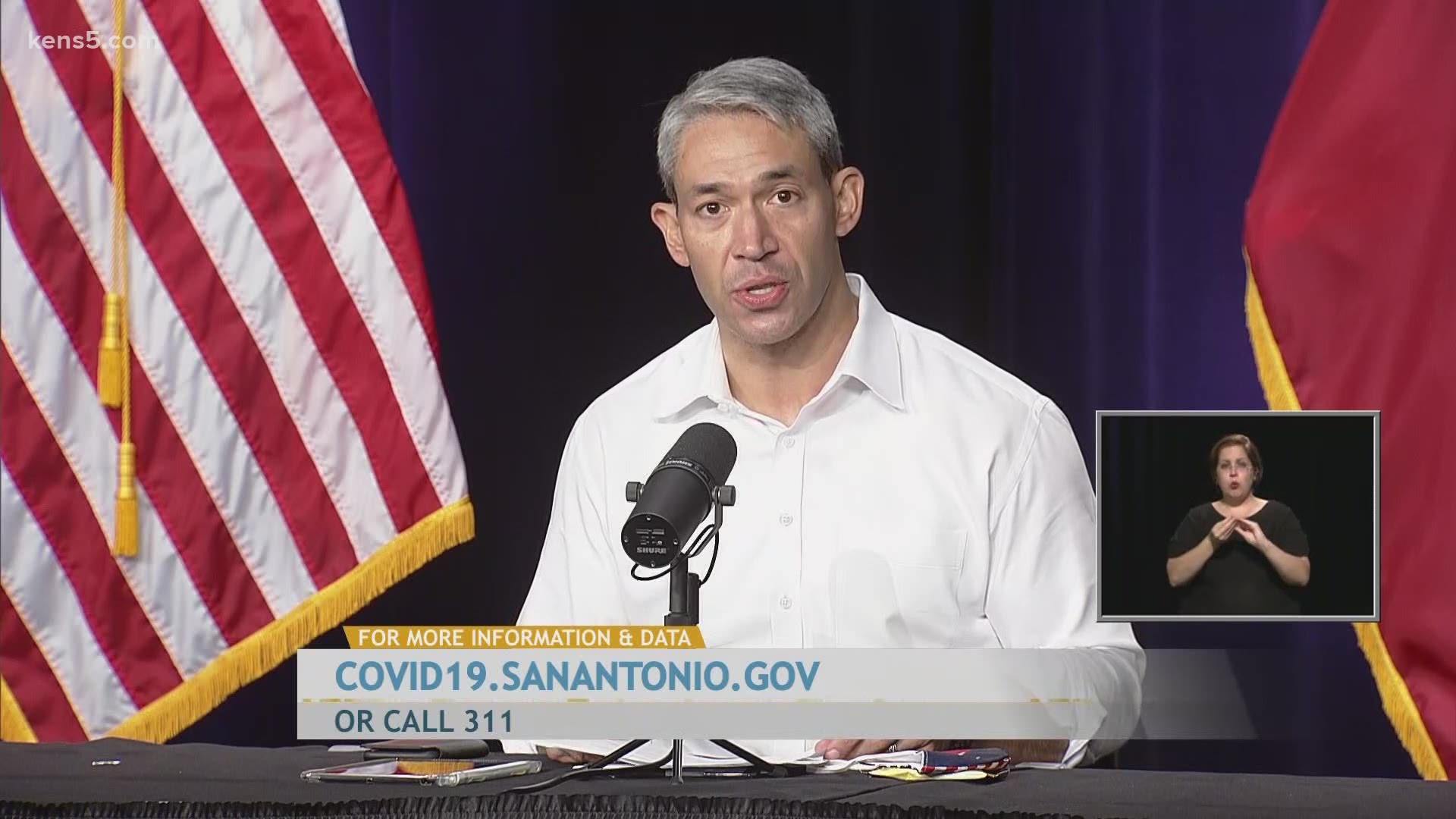SAN ANTONIO — We're tracking the latest numbers from the coronavirus pandemic in San Antonio and across Texas. Here are the latest numbers reported by Bexar and surrounding counties:
- Bexar County: 335 new cases and no additional fatalities from COVID-19 were reported Monday. There have been a total of 36,418 cases as the county death toll remains at 323.
- Comal County: The county reported 88 new cases on Saturday. Officials also confirmed the county's 45th death. There have been a total of 1,968 cases as of Saturday evening.
- Hays County: The county reported 70 new cases and one additional virus-related death on Monday. In all, 4,203 cases of COVID-19 have been confirmed in the county; 1,178 of those cases are considered active. The death toll is up to 25.
How Bexar County is trending
We're tracking how many coronavirus cases are confirmed in Bexar County each day from the time San Antonio Metro Health began reporting cases more than two months ago. Graphing those daily case numbers along a 14-day moving average provides an accurate picture of the curve in the San Antonio area and the direction we're heading amid the coronavirus.
On Monday, Mayor Ron Nirenberg reported 335 new cases of the novel coronavirus in Bexar County—the smallest daily total since July 5. Nirenberg continued to appeal to younger members of the population to practice mask-wearing and social distancing, saying that one in five cases in Bexar County is a patient in their 20s.

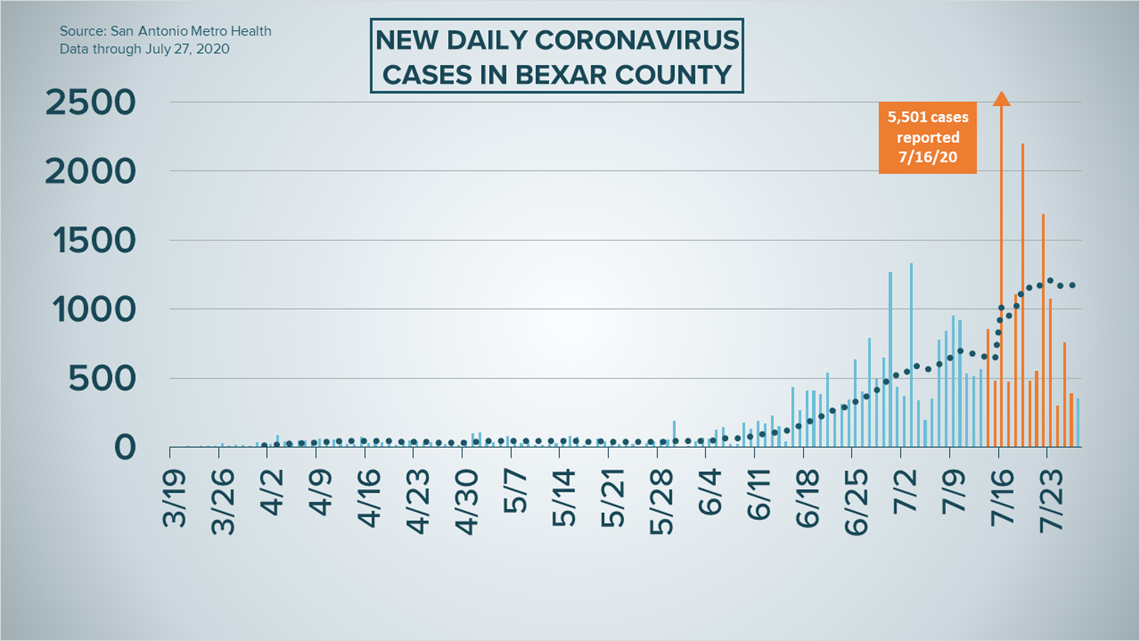
Meanwhile, for the first time since June 29 the county reported no new deaths from virus-related complications. The death toll remains at 323.

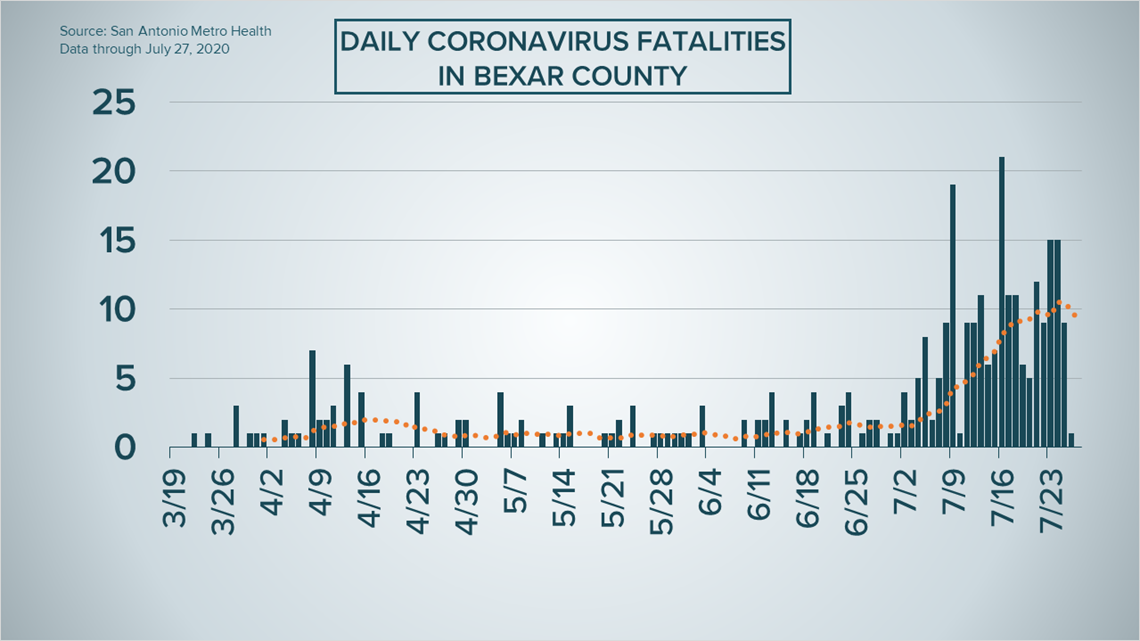
After seven straight days of decreasing hospitalizations, the trend reversed course slightly on Monday. Nirenberg reported that 1,073 Bexar County residents were receiving treatment for COVID-19, up slightly from 1,044 on Sunday.
The number of patients in intensive care (431) and using ventilators to help them breathe (294) are also up from Sunday.

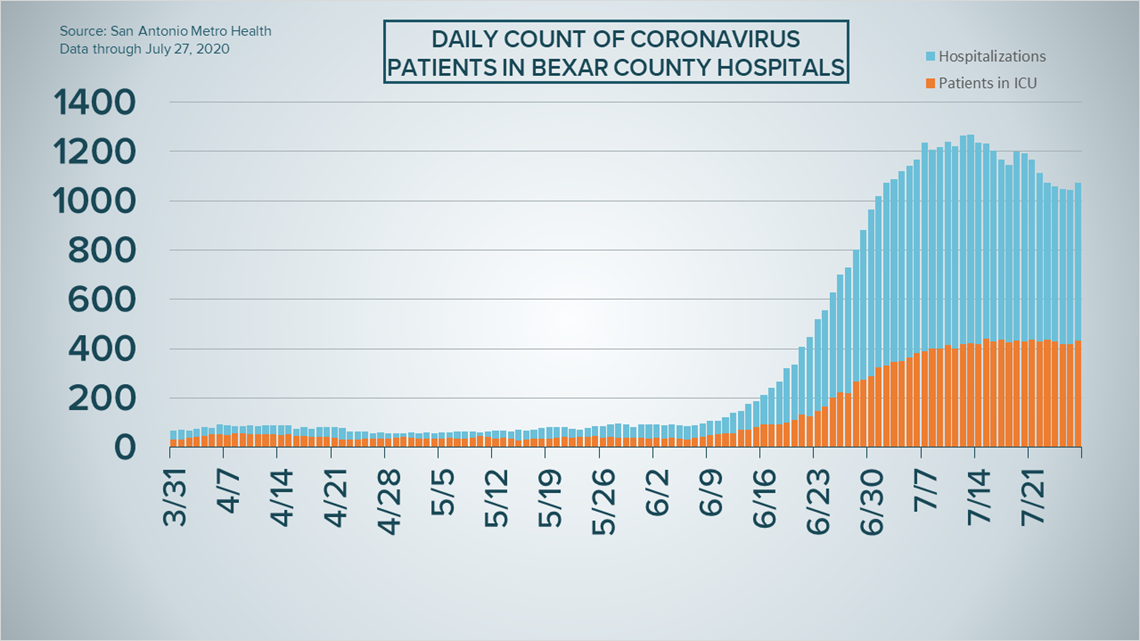
Coro

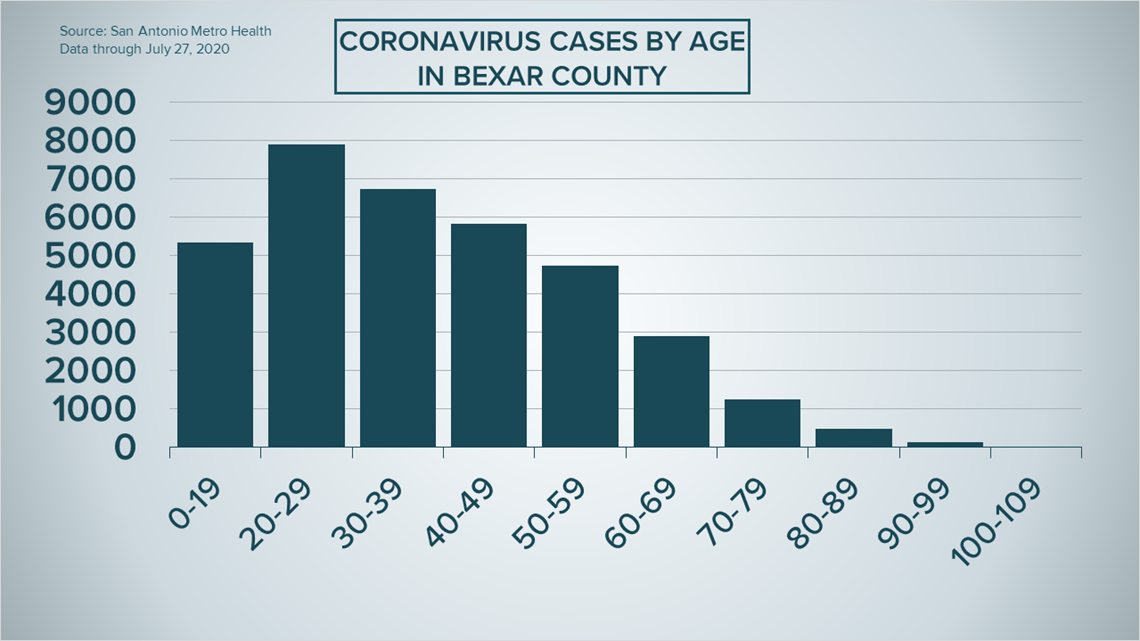
Coronavirus in Texas
State health officials on Monday reported an additional 4,267 cases of the coronavirus in the Lone Star State, bringing the total to 385,923. It's the first time since July 5 that Texas reported less than 5,000 new daily cases.

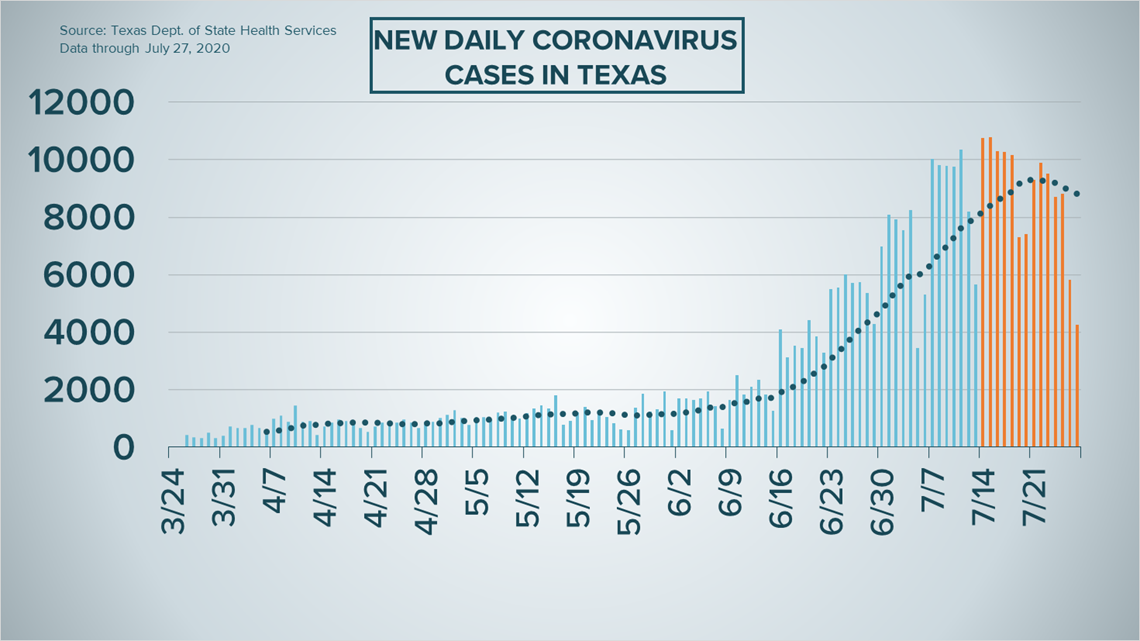
Texas also announced 675 new deaths from virus complications, but only 44 of those are from the last 24 hours. According to state health authorities, they are changing the way they count coronavirus fatalities from reporting numbers provided by regional health departments to gathering their own data from death certificates. The state says that will allow officials to report fatality numbers quicker and more comprehensively.

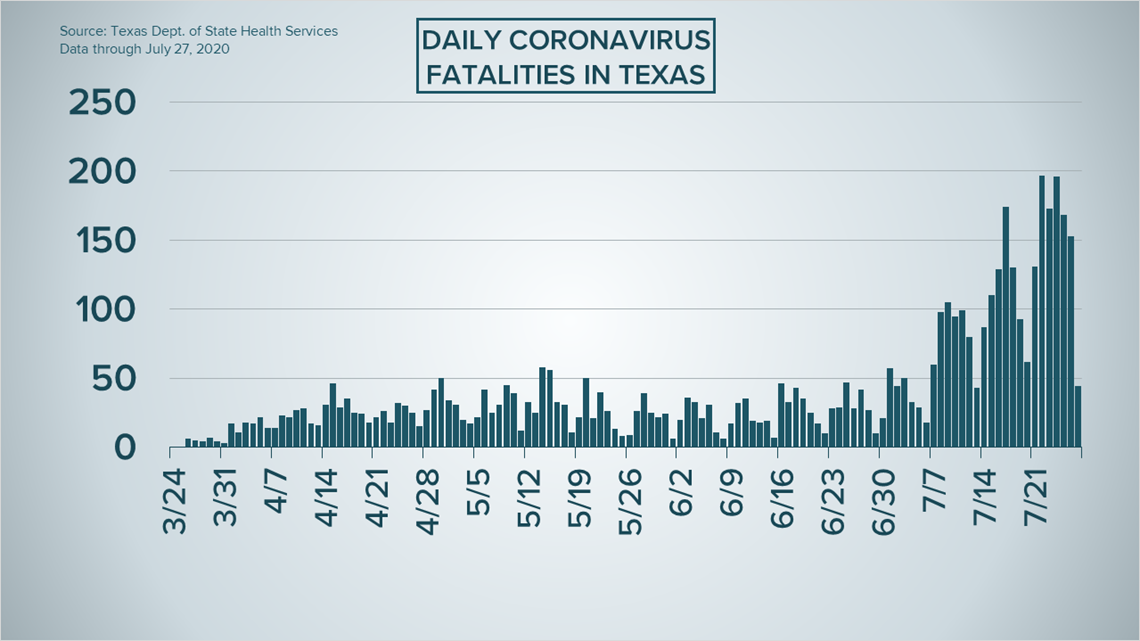
Meanwhile, for the fifth straight day, Texas says it's reporting incomplete hospitalizations data. The Department of State Health Services reported that 9,781 Texans are receiving treatment for COVID-19, but that represents information provided by just 82% of hospitals in the state.
The full statement from the department reads as follows:
DSHS is reporting incomplete hospitalization numbers 7/23-7/27 due to a transition in reporting to comply with new federal requirements. For July 27, 82 percent of hospitals reported complete data to DSHS, resulting in a partial data set and the appearance of a drop in hospitalizations. DSHS continues to work with Texas hospitals during this transition to ensure all facilities can fully report the data required.
An estimated 229,107 Texans have recovered, while 146,836 remain ill with the virus.
Latest Coronavirus Headlines
- GOP unveils 'HEALS' Act with another round of $1,200 stimulus checks
- Why Texas COVID-19 death numbers jumped on July 27
- Here's a list of retailers requiring face coverings for customers
- Dr. Hotez: 'Every day we're breaking new records in the Texas metro areas in terms of numbers of deaths'
- 2 stylists had COVID-19, but wore masks. 139 of their clients didn't become ill
- How to help kids deal with anxiety about catching coronavirus
- Kerrville woman says pandemic forced her to shutdown her homegrown business
- Your phone may have up to 10 times more bacteria than a toilet seat; how to clean it properly
- 'Hit the reset button' | Health professionals urge US shut down again in open letter
Coronavirus symptoms
The symptoms of coronavirus can be similar to the flu or a bad cold. Symptoms include fever or chills, cough, shortness of breath or difficulty breathing, fatigue, muscle or body aches, headache, new loss of taste or smell sore throat, congestion or runny nose, nausea or vomiting and diarrhea, according to the Centers for Disease Control.
Most healthy people will have mild symptoms. A study of more than 72,000 patients by the Centers for Disease Control in China showed 80 percent of the cases there were mild.
But infections can cause pneumonia, severe acute respiratory syndrome, kidney failure, and even death, according to the World Health Organization. Older people with underlying health conditions are most at risk.
On June 25, the CDC expanded the list of groups at a higher risk of severe illness due to coronavirus.
Experts determined there was consistent evidence these conditions increase a person's risk, regardless of age:
- Chronic kidney disease
- COPD (chronic obstructive pulmonary disease)
- Obesity (BMI of 30 or higher)
- Immunocompromised state (weakened immune system) from solid organ transplant
- Serious heart conditions, such as heart failure, coronary artery disease, or cardiomyopathies
- Sickle cell disease
- Type 2 diabetes
The CDC believes symptoms may appear anywhere from two to 14 days after being exposed.
Human coronaviruses are usually spread...
- Between people who are in close contact with one another (within about 6 feet).
- Through respiratory droplets produced when an infected person coughs, sneezes or talks. These droplets can land in the mouths or noses of people who are nearby or possibly be inhaled into the lungs.
- Some recent studies have suggested that COVID-19 may be spread by people who are not showing symptoms.
Help stop the spread of coronavirus
- Stay home when you are sick.
- Eat and sleep separately from your family members
- Use different utensils and dishes
- Cover your cough or sneeze with your arm, not your hand.
- If you use a tissue, throw it in the trash.
Lower your risk
- Wash your hands often with soap and water for at least 20 seconds. If soap and water are not available, use an alcohol-based hand sanitizer.
- Avoid touching your eyes, nose, and mouth with unwashed hands.
- Avoid close contact with people who are sick.
- Clean and disinfect frequently touched objects and surfaces.
- The CDC recommends wearing a mask or cloth face covering if you have to be out due to an essential service or essential activity such as going to the grocery store.
- If you are 60 or over and have an underlying health condition such as cardiovascular disease, diabetes or respiratory illnesses like asthma or COPD, the World Health Organization advises you to try to avoid crowds or places where you might interact with people who are sick.

